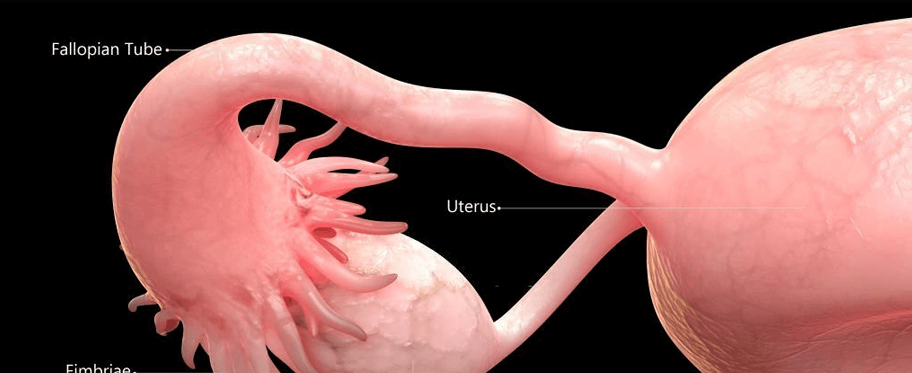
Blocked or Damaged Fallopian Tube and Fertility
Your fallopian tubes are an important passageway for an egg and a sperm to meet and for a fertilized egg (embryo) to make its way to your uterus. The health of your fallopian tubes impacts your fertility. Blocked or damaged fallopian tubes can make it difficult for individuals and couples to become pregnant.
What are fallopian tubes?
Your fallopian tubes are a pair of hollow, muscular ducts located between your ovaries and your uterus. Each fallopian tube is a channel between your ovaries, where your body makes eggs, and your uterus, where a fertilized egg can develop into a fetus. Fertilization occurs in your fallopian tubes, making it a key part of your reproductive anatomy that affects your fertility.
What is the role of your fallopian tubes?
Your fallopian tubes play an important role in conception and pregnancy. Think of a fallopian tube as:
- A holding place for your egg: Each month, one of your ovaries releases a mature egg as part of your menstrual cycle. Finger-like structures at the end of your fallopian tube, called fimbriae, sweep the egg into the tube, where the egg waits to be fertilized.
- The site where fertilization happens: If your partner ejaculates during intercourse, their sperm travels through your vagina, cervix, uterus and eventually into your fallopian tubes. Fertilization happens in your fallopian tubes when an egg and sperm meet.
- An active passageway that moves a fertilized egg to your uterus: A fertilized egg (embryo) travels through your fallopian tubes until it reaches your uterus, where it can grow into a fetus. Your fallopian tube consists of powerful muscles that move the embryo along.
Can you get pregnant with one fallopian tube?
Yes. You may have been born with only one fallopian tube, or you may have had a fallopian tube removed because of a condition or injury. If you have at least one healthy fallopian tube and ovary, and your menstrual cycle is normal, you can still get pregnant.
You can also get pregnant without your fallopian tubes. In vitro fertilization (IVF) is an option for individuals and couples who wish to have a baby that doesn’t require fallopian tubes at all.
What are the parts of a fallopian tube?
A fallopian tube has four parts:
- Infundibulum: The funnel-like portion of your fallopian tube that’s closest to your ovaries. It includes finger-like structures called fimbriae that reach out toward the ovary. A single fimbriae called the fimbria ovarica is long enough to reach your ovary. The fimbriae catch an egg once it’s released from your ovary and sweep it gently into your fallopian tube.
- Ampulla: The major channel in your fallopian tube, located in-between the infundibulum and the isthmus. Fertilization most often takes place in the ampulla.
- Isthmus: A tiny channel that connects the ampulla to the portion of your fallopian tube that’s closest to your uterus, the intramural portion.
- Intramural (interstitial) portion: The part of your fallopian tube that extends into the top of your uterus. It opens into your uterine cavity, where an embryo can implant into your uterine wall and develop into a fetus.
What are the common tests to check the health of your fallopian tubes?
The most common tests check for blockages in your fallopian tubes that may be making it hard for you to become pregnant.
- Hysterosalpingogram (HSG): An x-ray dye test used to diagnose problems related to pregnancy and fertility. A HSG can show whether your fallopian tubes are blocked.
- Hysteroscopy: A procedure that uses a thin lighted instrument called a hysteroscope to look inside your uterus. It often follows an HSG and can confirm whether your fallopian tubes are blocked.
- Saline-infusion sonography (sonohysterogram): An ultrasound procedure that produces an image of your uterus while it’s filled with saline. It can show whether your fallopian tubes are blocked.
- Hysterosalpingo contrast sonography (HyCoSy): An ultrasound that produces an image of your fallopian tubes while they’re filled with a solution that contains air bubbles or foam. The solution’s movement can reveal blockages.
- Laparoscopy: A surgical procedure that uses a small lighted camera called a laparoscope to show whether your fallopian tubes are blocked. Your provider may recommend a laparoscopy and dye test, which allows them to see how the dye is (or isn’t) moving through your fallopian tubes.
TREATMENT
In some situations where small amounts of scar tissue or adhesions are causing a blockage, laparoscopic surgery may be an option. This procedure opens the tube by removing the blockage. If there are large amounts of scar tissue, removal may not be possible. Sometimes surgery can successfully repair fallopian tubes damaged by ectopic pregnancy or infection. When a part of the fallopian tube is damaged and causing a blockage, the damaged area can be removed, and the healthy parts of the tube are then connected.
Chawla Nursing Home provides a variety of options for those experiencing infertility. When you are having trouble starting your family, contact us. Schedule a consultation appointment with one of our fertility specialists, and let us help you start building your family.
Schedule An Appointment
Get your Appointment Confirm with us Easily

